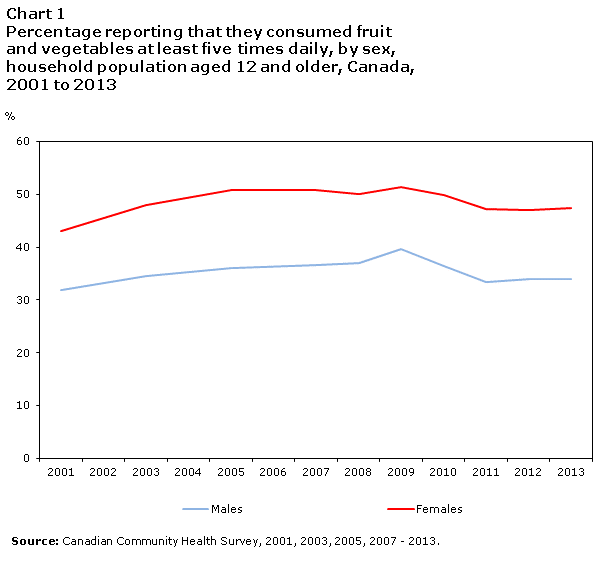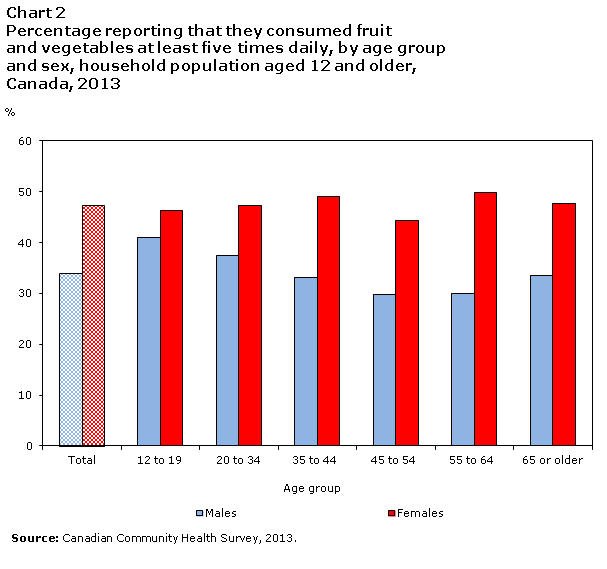Fruit and vegetable consumption, 2013
Archived Content
Information identified as archived is provided for reference, research or recordkeeping purposes. It is not subject to the Government of Canada Web Standards and has not been altered or updated since it was archived. Please "contact us" to request a format other than those available.

Fruit and vegetables are an important source of vitamins, minerals and fibre. A diet rich in fruit and vegetables may reduce the risk of heart disease and some types of cancer.Note 1
Fruit and vegetable consumption data are based on a survey question that measures the number of times respondents reported that they consumed fruit and vegetables, rather than the actual quantity consumed.
In 2013, 40.8% of Canadians aged 12 and older, roughly 11.5 million people, reported that they consumed fruit and vegetables five or more times per day. This rate has remained unchanged since 2011. Reported fruit and vegetable consumption had increased to 45.6% in 2009, and then decreased two years in a row in 2010 and again in 2011, marking the first decline in the rate since 2001.
From 2001 to 2013, females were more likely than males to consume fruit and vegetables five or more times daily. In 2013, 47.4% (6.8 million) of females consumed fruit and vegetables five or more times daily, compared to 34.0% (4.7 million) of males (Chart 1).

In 2013, more than 44% of females in each age group reported that they ate fruit and vegetables five or more times daily. The rate was higher for females than for males in all age groups. Young males aged 12 to 19 (41.0%) were more likely to consume fruit and vegetables five or more times a day compared to males in all other age groups (Chart 2).

The proportion of residents who reported eating fruit and vegetables at least five times daily was lower than the national average (40.8%) in:
- Newfoundland and Labrador (25.5%)
- Prince Edward Island (32.5%)
- Nova Scotia (33.3%)
- New Brunswick (35.9%)
- Ontario (39.4%)
- Manitoba (31.9%)
- Yukon (32.6%)
- Nunavut (23.3%)
The proportion of residents who reported eating fruit and vegetables at least five times daily was higher than the national average only in Quebec (46.9%).
Residents of Saskatchewan, Alberta, British Columbia, and Northwest Territories reported rates that were about the same rate as the national average.
End note
References
Garriguet, Didier. 2007. “Canadians’ eating habits.” Health Reports. Vol. 18, no. 2. May. Statistics Canada Catalogue no. 82-003. p. 17–32. http://www.statcan.gc.ca/pub/82-003-x/2006004/article/habit/9609-eng.pdf (accessed May 10, 2010).
Pérez, Claudio E. 2002. “Fruit and vegetable consumption.” Health Reports. Vol. 13, no. 3. March. Statistics Canada Catalogue no. 82-003. p. 23–31. http://www.statcan.gc.ca/studies-etudes/82-003/archive/2002/6103-eng.pdf (accessed May 10, 2010).
Data
Additional data from the Canadian Community Health Survey are available from CANSIM table 105–0501.
- Date modified:
